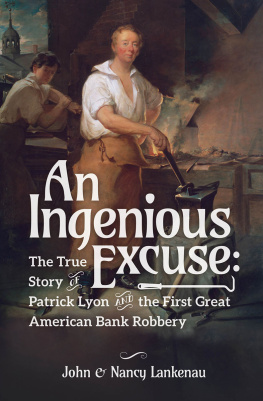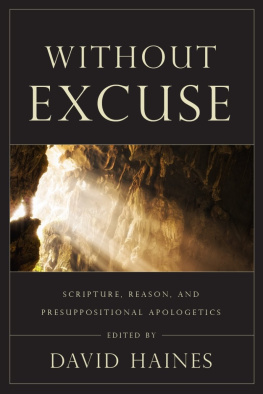John and Nancy Lankenau - An Ingenious Excuse
Here you can read online John and Nancy Lankenau - An Ingenious Excuse full text of the book (entire story) in english for free. Download pdf and epub, get meaning, cover and reviews about this ebook. year: 2020, publisher: Little Creek Press, genre: Detective and thriller. Description of the work, (preface) as well as reviews are available. Best literature library LitArk.com created for fans of good reading and offers a wide selection of genres:
Romance novel
Science fiction
Adventure
Detective
Science
History
Home and family
Prose
Art
Politics
Computer
Non-fiction
Religion
Business
Children
Humor
Choose a favorite category and find really read worthwhile books. Enjoy immersion in the world of imagination, feel the emotions of the characters or learn something new for yourself, make an fascinating discovery.
- Book:An Ingenious Excuse
- Author:
- Publisher:Little Creek Press
- Genre:
- Year:2020
- Rating:3 / 5
- Favourites:Add to favourites
- Your mark:
- 60
- 1
- 2
- 3
- 4
- 5
An Ingenious Excuse: summary, description and annotation
We offer to read an annotation, description, summary or preface (depends on what the author of the book "An Ingenious Excuse" wrote himself). If you haven't found the necessary information about the book — write in the comments, we will try to find it.
An Ingenious Excuse — read online for free the complete book (whole text) full work
Below is the text of the book, divided by pages. System saving the place of the last page read, allows you to conveniently read the book "An Ingenious Excuse" online for free, without having to search again every time where you left off. Put a bookmark, and you can go to the page where you finished reading at any time.
Font size:
Interval:
Bookmark:


Copyright 2020 John and Nancy Lankenau
Little Creek Press
A Division of Kristin Mitchell Design, Inc.
5341 Sunny Ridge Road
Mineral Point, Wisconsin 53565
Book Design and Project Coordination:
Little Creek Press
First Edition
August 2020
All rights reserved.
No part of this book may be used or reproduced in any manner whatsoever without written permission from the authors.
Printed in the United States of America
For more information or to order books:
visit www.littlecreekpress.com
Library of Congress Control Number: 2020912833
ISBN-13: 978-1-942586-82-1

Front cover art: John Neagle, Pat Lyon at the Forge (1826-27), Museum of Fine Arts, Boston.
Back cover art: Wm. Birch & Son, Goal, in Walnut Street Philadelphia (1799).

Many thanks to accessible digital libraries and the
dedicated professionals of the Historical Society of
Pennsylvania, the Pennsylvania Historical and Museum
Commission, the Philadelphia City Archives, the American
Philosophical Society, the Library of Congress, the Supreme
Court of Pennsylvania, the Historical Collections of Christ
Church, the archives of FamilySearch, and the Temple
University Libraries. The archivists and librarians of
these institutions preserve history for all of us.
Without them, this story could not be told.

Any honest man must consider his character as the most inestimable treasure in his possession, and of which he ought to be a vigilant guardian.
Patrick Lyon

T his is the true story of how an aspiring young immigrant, framed for the first great American bank robbery, uses the spirit of independence to stand up against the rich and powerful. It begins in Philadelphia on the night of September 1, 1798. The people and events in this story are real.
How do we know so much about something that happened back in 1798? Patrick Lyon, the blacksmith charged in the robbery of the Bank of Pennsylvania, wrote while imprisoned at the Walnut Street Jail. His writings are published as The narrative of Patrick Lyon.
Samuel Fox, the president of the Bank of Pennsylvania, wrote his own explanation of events about the robbery. His narrative is included as an entry in the Bank of Pennsylvania Stockholder Minutes. Although unpublished, these papers are preserved in the collections of the Historical Society of Pennsylvania.
Two detailed accounts of the trial remain. Notes taken in shorthand by independent reporter Thomas Lloyd are published as the Robbery of the Bank of Pennsylvania in 1798. Handwritten trial notes of Justice Jasper Yeates are kept in the collections of the Historical Society of Pennsylvania. His records of the proceedings are surprisingly readable.
These and other firsthand accounts, as well as pictorials, letters, newspapers, directories, and records, were gathered out of archives and libraries located all over the United States and the United Kingdom. They are the brick and mortar of each scene in this true tale of history. Many excerpts are highlighted in italics. Those excerpts appear with the original spelling, capitalization, and punctuation. Explanatory research notes, citations, and resources are listed at the end.
Firsthand accounts of conversations and events have been painstakingly reconstructed into individual scenes with dialogue. Although dialogue is a dramatic technique more commonly associated with fiction, it is well-suited to telling this story. The historical record abounds with accounts of conversations, courtroom testimony, and legal argument.
To maintain the dramatic pace, some incidents are condensed, and some are left out entirely. Several jumps in time are required to tell this story. These dramatic transitions are distinct. None of the dramatic techniques impinge on the overall historical accuracy of the story.
It goes without saying that no one knows for sure what was said or done all of those many years ago. Even the firsthand accounts differ when compared side-by-side. Interestingly, multiple accounts of the same event are individual pieces of a giant puzzle. They fit together to form a picture, although not the complete picture one might enjoy if reading fiction.
In his struggle to uncover the truth behind the robbery, Patrick exposes the hidden world of gentlemanly schemes and exploits. It is a rare and extraordinary glimpse into early patrician America. Patrick writes with exquisite clarity. Still, he mentions his family and friends only in the context of events relating to the robbery.
As a blacksmith, earning his living by daily labor, Patrick didnt have leisure time to write about his everyday life and the people in it. He remarks, I am more accustomed to mechanics than to authorship. Other than occasional letters, likely long since gone, Patrick wrote to defend himself against accusations made by the bank.
The robbery of the Bank of Pennsylvania is the core event that sets everything in motion. Characterized in the title of this story as the first great American bank robbery, the reader may wonder: Was there was an earlier bank robbery in America? The answer is yes, and it happened on the island of Nantucket, Massachusetts, in 1795.
The Nantucket Bank, situated next door to the hat shop on Main Street, was robbed of $20,927 in gold and silver coins. The event was reported in newspapers across many states. It was devastating to the small community. So why is the bank robbery in Philadelphia characterized as the first great American bank robbery?
The magnitude of the Bank of Pennsylvania robbery was many times over that plundered from the coffers of whaling fishermen on Nantucket Island. The cash vault in Philadelphia contained the vast riches of an elite and influential community. Philadelphia was the capital city of America.
Although the story of an innocent person wrongfully accused is as old as history itself, this tale of innocence hangs upon the founding promise of a young country. Patrick Lyon, a recent immigrant, discovers the truths written in the Declaration of Independence to be anything but self-evident. Bankers infected by power leave him to die in a fever-ridden jail. Herein hangs the tale. 


SEPTEMBER 1 SEPTEMBER 2, 1798
A malady of spirit drifted in the sultry night air of Philadelphia. Comfortable dwellings stood empty. Cobble-paved streets lay quiet. Two night watchmen with guard dogs walked from front to back around Carpenters Hall, the stately red-bricked building situated off Chestnut Street. A fortune in silver, gold, and banknotes sat just inside.
Next pageFont size:
Interval:
Bookmark:
Similar books «An Ingenious Excuse»
Look at similar books to An Ingenious Excuse. We have selected literature similar in name and meaning in the hope of providing readers with more options to find new, interesting, not yet read works.
Discussion, reviews of the book An Ingenious Excuse and just readers' own opinions. Leave your comments, write what you think about the work, its meaning or the main characters. Specify what exactly you liked and what you didn't like, and why you think so.









